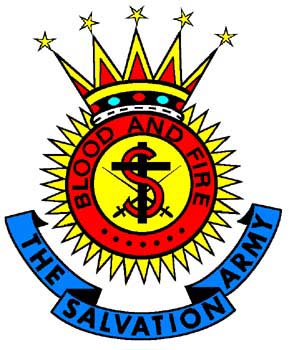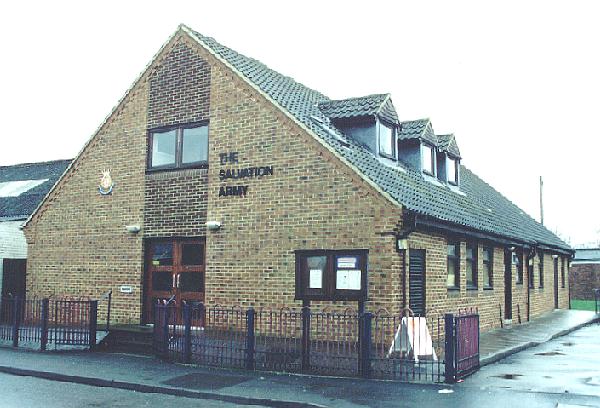The evangelical Christian movement known as the Salvation Army originated in the mid-19th century and now has an international presence with representatives in many countries around the world. The prime mover was William Booth who founded the social service and social reform organisation in London in 1865 under the name of the Christian Revival Association. Five years later it was renamed the East London Christian Mission but from 1878 it has been known as the Salvation Army. Leaders have military titles and the movement is renowned for its distinctive blue and red uniforms, brass bands and a weekly journal called the War Cry that is still sold by members during visits to public houses.
The Salvation Army's presence in Bourne became established during the closing years of the 19th century. The first recorded meeting was held at the Victoria Hall in Eastgate on Wednesday 3rd August 1881 conducted by Captain Clarke and Lieutenant Hatchett when according to the Grantham Journal "there was a large but noisy attendance". Visiting officers continued to hold the meetings and the Corps Number 1314 for Bourne was, according to army records, initiated on 4th June 1887. By 1890, the meetings were being conducted by two officers who travelled in from Spalding, Captain Pryke and Lieutenant Clarke, and sales of the War Cry were beginning to increase as a result. There is no record of the Salvation Army's activities in the town after that until 27th November 1909 when the Corps of Bourne was formally inaugurated by Major Wilson, meeting in various premises until the first meeting hall was opened in 1924 in an old corrugated iron hut previously owned by the YMCA that had been erected on the Abbey Lawn, sited on what is now the garden area north east of the cricket pavilion. The building was used as a clubroom for servicemen returning from the Great War of 1914-18 but interest waned and the last members vacated the premises in the winter of 1923. The following year, it was bought by the Salvation Army and the official opening was held on Saturday 6th September 1924 when the ceremony was performed by local solicitor Major Cecil Bell. The event was reported by the Stamford Mercury which said: A NEW HOME - OPENING OF SALVATION ARMY'S CITADEL
The
proceedings were conducted by Major Pimm, the divisional commander
of the Army from Leicester, and among those present were
representatives from the surrounding districts and the members of
the Farcet Salvation Army Band who led the singing of hymns. The hut continued in use by the Salvation Army for almost 60 years and after they moved out it stood empty for a spell before being demolished to make way for the Horace Stanton memorial garden which was opened at the Abbey Lawn in 1983. For a while, the Army had no permanent home but there was a renewed activity in the movement after Salvationists Norman and Janice Paskin were transferred from Lincoln to the Salvation Army at Stamford and who wanted to do something in Bourne, the town where they lived. After two years of prayer and preparation, they started a Sunday School on the first floor of the red brick shop and workshop premises behind West Street occupied by the printing firm Ernest Fytche and Co [now Fovia Ltd]. The number of children attending grew and this inspired them to start Sunday morning worship for the entire family. In 1988, Captain Sue Hopkins moved to Bourne and continued with the work and this included the purchase of land in Manning Road and the building of the present permanent headquarters. Ironically, the purchase of the land came after a casual conversation between Captain Hopkins and a man connected with the site while she was selling the War Cry at the Mason's Arms in South Street one evening in April 1989. Sale negotiations, design and obtaining planning permission took a further year and was eventually granted by South Kesteven District Council in May 1990 despite an objection about possible noise from a resident living nearby who wrote: "It is a tradition of the Salvation Army that frequent use is made of brass bands. The end of the proposed ground floor hall is about four metres from my kitchen window and I see no reference in the plans for sound insulation." The problem, however, was overcome, and once the Salvation Army was given the green light, the project was completed in just 18 weeks, opening in the autumn of 1990 at a total cost of £400,000. The building has a capacity of 120 although one meeting attracted a congregation of 200. The opening of the citadel was attended by the leaders of the Salvation Army in the United Kingdom at the time, Commissioner and Mrs Harry Read. Since then, the corps has seen a further
five sets of officers including the current
leaders, Majors Richard Durrant and his wife Heather, who arrived in July 2007.
See also The YMCA hut REVISED DECEMBER 2012
Go to: Main Index |

